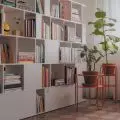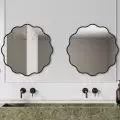Social Square stirs up a lot of emotions, especially among Wroclaw residents. For more than two decades there has been a never-ending discussion about what to do with the place in the city center, which gives the impression of abandonment. There have already been several competitions and ideas, but none of the plans have been implemented. Students from the Wroclaw University of Technology, as part of the course "Designing Public Buildings in the Structure of the City" under the direction of Agnieszka Tomaszewicz, Jacek Kotz and Jacek Wiszniowski, proposed their proposals for the development of the square.
From left: Aurelia Durlej, Adriana Mrozinska, Izabella Stanula
© Wrocław University of Technology
controversial square
We wrote about the idea of creating an eco-center in the Social Square on our portal in 2019. Since then, there have been several concepts for the development of the square, and none has been realized. Deputy Mayor of Wroclaw Jakub Mazur said this about the City's plans:
In 2019, with the European Investment Bank, we started thinking about how to do it on a European scale. We want to combine our vision with business plans. So we are also talking to the world's biggest developers, who are able to build, together with us, a new piece of Wroclaw.
From left: Maja Snopek, Kinga Fajkowska
© Wroclaw University of Technology
The Non-Partisan Wrocław Association, in turn, proposed to create a space that would be developed according to an idea chosen by the city's residents and citizens in an extended competition procedure. The inspiration here was the transformation of the Spanish Square in Madrid (Plaza de España).
from left: Maja Wołowiec, Julia Glina
© Wroclaw University of Technology
student concepts
Students of the Faculty of Architecture at Wroclaw University of Technology also presented their ideas. Their task was to develop a form and function that would fill the current "void" in the Social Square, giving the place an urban character and reintegrating it into the city. The main challenges included creating a multifunctional development structure, prioritizing pedestrian, bicycle and public transportation, and focusing on resilience to climate change.
From left: Katarzyna Dyderska, Eliza Korytkowska
© Wrocław University of Technology
From left: Katarzyna Perucka, Katarzyna Zatońska, Ewa Noskowicz
© Wroclaw University of Technology
areopag
The "Areopag" project, by Aurelia Durlej, Adriana Mrozińska and Izabella Stanula, envisages the creation of a multifunctional space in the front yard of the Provincial Office, which would serve as a public square and an interchange for the Rapid Urban Rail and public transportation. The creation of a community gathering place is justified not only by the multimodal transportation hub, but also by the proximity of services and greenery. Collision-free pedestrian and bicycle thoroughfares were ensured by multi-level zoning of Areopag, with the Rapid Urban Rail deep underground and a pedestrian passage from Juliusz Słowacki Park toward Grunwald Bridge, under the main roads. From the axis of the Peace Bridge, a streetcar line is routed that crosses the premise.
Aeropag
© Aurelia Durlej, Adriana Mrozinska and Izabella Stanula
The structure of the project maintains a coherent form, with individual segments connected by footbridges and terraces. The developed interiors of the courtyards provide residents and residents with space for integration and relaxation, and the project introduces greenery into the quarters and compositionally extends Slowackiego Park. New features include multi-family housing and a multi-functional gathering plaza, using horizontal zoning to ensure that the space is used consistently, regardless of the day or time. By reducing the height of the development toward the river and ensuring the permeability of aeration corridors, the concept respects spatial considerations. The restoration of the historic course of the city moat as a potential retention res ervoir is also under consideration. The proposed concept fills an existing gap in the urban fabric, creating an organized form with pedestrian priority and use of the site for a multifunctional interchange.
Aeropag
© Aurelia Durlej, Adriana Mrozinska and Izabella Stanula
megastructure
"Megastructure," proposed by Kinga Fajkowska and Maja Snopek, focuses on changing the function of the Social Square from transportation to housing and services. The goal is to transform the empty square into a vibrant place for the community, making effective use of undeveloped space. The proposal is to connect the boulevards along the river into a single green corridor. The development concept is based on a megastructure that gradually rises in terraces on the side of Slowackiego Park, allowing greenery to penetrate deep into the area. On the other sides, the structure harmonizes with the existing buildings. A climbing pedestrian walkway on the extension of the Grunwaldzka axis allows the structure to rise in a way that is almost imperceptible to passersby. The shape of the megastructure was designed with lighting conditions in mind, and cutouts in the form of plazas and courtyards provide adequate interior lighting. The conical elements visible in the model indicate the suggested locations and heights of the dominant buildings, referring to the high-rise complex across the Oder River, known colloquially as "Manhattan."
Megastructure
© Kinga Fajkowska, Maja Snopek
The first floor of the outer frontage is used for service, retail and catering functions. The inner parts without access to sunlight are used for parking lots, warehouses and technical rooms. On the upper floors, the outer lots are reserved for apartments, while the parts near the pedestrian thoroughfare along the axis will be occupied by retail, office and cultural services. All vehicular traffic, including the tramway, has been placed underground, giving priority to pedestrian and bicycle traffic. The main pedestrian routes have been laid out along the axes of the Grunwaldzki and Pokoju bridges, as well as the proposed footbridge on the extension of Na Grobli Street.
Megastructure
© Kinga Fajkowska, Maja Snopek
sunny square
"Sunny Square" created by Julia Glina, Maja Joniec and Maja Wolowiec preserves the existing greenery next to the Provincial Office and continues the one in Juliusz Słowacki Park. In order to emphasize the Grunwaldzka axis, tree rows have been provided on both sides of it, as well as their placement in several places in the center of the area, which provides better lighting for the plants. Green avenues lead from the project's main axis to the boulevards on the Oder River, creating green corridors that promote ventilation of the area and minimize smog.
Sunny Square
© Julia Glina, Maja Joniec, Maja Wolowiec
The project takes into account Wroclaw's largest aeration corridors - the Odra and Oława rivers. In order to reduce the phenomenon of the urban heat island, it was proposed to lower the height of buildings towards the river and to place buildings at intervals that ensure adequate ventilation of the area. Pedestrian safety was ensured by raising walking and bicycle paths above the surface. The project places great emphasis on pedestrian traffic, creating pro-social plazas at strategic points. Vehicular traffic on the Grunwaldzka axis was reduced, introducing underpasses in the north-south direction and designing the development around public places and pedestrian routes. For the authors, it was important to emphasize cultural heritage by exposing view axes to important elements of the space. St. Maurice's Church, as one of the main dominants, was particularly highlighted in the new urban layout.
Sunny Square
© Julia Glina, Maja Joniec, Maja Wolowiec
green avenues
The "Green Avenues" concept, developed by Natalia Papieska, Katarzyna Dyderska and Eliza Korytkowska, is based on the integration of urban greenery with urban space, creating green avenues connecting different parts of the city with the river. Thoughtful reorganization of traffic, including the transfer of vehicular traffic underground, made it possible to implement a modern urban layout, harmoniously integrated into the existing structure of the city. The dynamic compositional axes, delineated by the Peace Bridge and the Grunwald Bridge, were emphasized with greenery, giving them a unique character.
Green Avenues
© Natallia Papieska, Katarzyna Dyderska, Eliza Korytkowska
The buildings in the area are characterized by varied lines and heights, allowing the architecture to blend seamlessly, as well as creating new green squares that are pleasant recreational and social spaces.
Green Avenues
© Natalia Papieska, Katarzyna Dyderska, Eliza Korytkowska
green square
"Green Square" by Katarzyna Zatonska, Katarzyna Perucka and Ewa Noskowicz, focuses on the introduction of extensive urban greenery, connecting the key points of the Social Square, offering an alternative to traditional streets. The green corridors, separated from automobile traffic, create safe spaces for pedestrians and cyclists, and their direct contact with buildings allows for the creation of restaurant gardens and outdoor storefronts. The project envisages a long promenade along the bank of the Oder River, connecting the Peace Bridge with the Dyke Bridge , as well as green lanes surrounding the church, creating connectors between the main streets. Also designed is a garden in front of the Provincial Office, connected to the Juliusz Słowacki Park. The key elements of the concept are the view axes, running across the Grunwald Bridge, the Peace Bridge and the eastern bank of the river, along which the main streets ending in dominant features are routed.
Green Square
© Katarzyna Zatońska, Katarzyna Perucka, Ewa Noskowicz
Thecenter of the project is formed by a traffic circle, surrounded by three squares, with dominants, two of which are designed, and the third is the existing tower of the Polish Post Office building. Additional squares are planned in front of the Provincial Office, next to the bridge on the Dyke side, and a triangular square in front of the Impart entrance.
Green Square
© Katarzyna Zatońska, Katarzyna Perucka, Ewa Noskowicz
Changes to the Social Square could become a key element in the transformation of one of the most important contemporary districts of Wroclaw, if the vision can be combined with real action. It would be worth looking at student proposals focusing on sustainable design.






























































































































